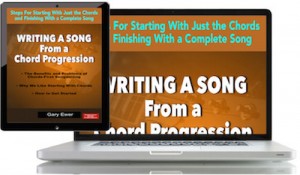If you like starting the songwriting process by figuring out a good chord progression, you probably like how chords very quickly convey a mood. And once you’ve got that mood, you find that other things fall into place quickly, especially a song topic, tempo, rhythmic treatment, and so on.
But there are some potential problems with the chords-first method, and the main possible problem is that melodies can tend to get ignored.
 The chords-first songwriting process, when used properly, can help you come up with some great songs! Be sure to avoid the inherent pitfalls, though. “Writing a Song From a Chord Progression” shows you how to get melodies and lyrics working properly with the chords you’ve come up with. Get it separately, or as part of the 10-eBook Bundle.
The chords-first songwriting process, when used properly, can help you come up with some great songs! Be sure to avoid the inherent pitfalls, though. “Writing a Song From a Chord Progression” shows you how to get melodies and lyrics working properly with the chords you’ve come up with. Get it separately, or as part of the 10-eBook Bundle.
But the chords-first process has a lot going for it, as long as you keep some important things in mind. Here’s a list of what I think of as the top five tips you must keep in mind while using a chords-first songwriting process:
- Think about possible melodies as soon as possible in the process. Playing chords over and over can be mesmerizing, but listeners’ musical minds tend to dismiss chords and start looking for other musical structures, like melody and lyrics. As you play through those three or four chords that you’ve discovered work well together, start humming melodies.
- Find ways to mix major and minor chords within the same progression. There’s nothing wrong with progressions that are all major or all minor, but I think you’ll like the possibilities of mood when you mix major and minor together. C-F-G7-C is fine, but C-Am-G7-C, or C-Dm-G7-C offers more mood possibilities.
- Don’t worry if your chords aren’t overly interesting on their own. With melody and lyrics, you do need to think about how to make them interesting, but chords are similar to a piece of land upon which you build a house: its most important function is that it needs to support whatever you build on it. What may seem like a boring chord progression may actually be doing the very important job of supporting the melody. That melody is what should be interesting and creative.
- The end of a repeating chord progression needs to connect back to the start of the progression. There’s always the possibility of a bit of a musical “jolt” if you don’t carefully examine how the end of a progression moves back to the start. So play your last chord, then your first one, and determine if it’s creating a sound or moment that you like.
- Don’t start every song using the chords-first method. There is a sameness that happens when you use the same process for every song. So if you started your most recent song by focusing on chords first, try melody first or lyrics first. The more you switch up your processes, the more diversity of style your fans will hear in your songwriting, and that’s a good thing.
 Written by Gary Ewer. Follow Gary on Twitter
Written by Gary Ewer. Follow Gary on Twitter
 Practice makes perfect, but only if you aren’t reinforcing mistakes. Get going in the right direction – Get “The Essential Secrets of Songwriting” 10-eBook Deluxe Bundle, and this special deal.
Practice makes perfect, but only if you aren’t reinforcing mistakes. Get going in the right direction – Get “The Essential Secrets of Songwriting” 10-eBook Deluxe Bundle, and this special deal.










